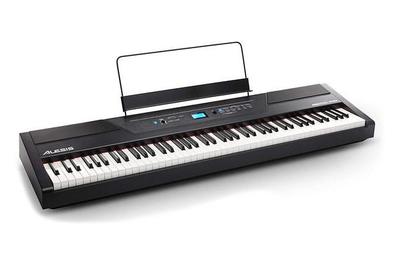A good digital piano offers the most practical way to learn how to play piano. Compared with an acoustic piano, a digital piano is less expensive, more compact, more portable, more affordable, and more versatile—and it never needs tuning.
The best digital pianos feel and sound so much like the real thing that students will easily transition to an acoustic piano. Among budget models priced around $600 or less, the Roland FP-10 comes closest to the sound and touch of a real grand piano, which is why we recommend it as the ideal way to begin your (or your child’s) journey with music.
Our pick
The Roland FP-10 is our favorite budget digital piano because it delivers a playing experience similar to that of an acoustic piano without the intrusive size and upkeep. It even simulates escapement, the feeling you get on an acoustic piano when the hammer drops away after striking the strings. The FP-10’s simulation of a grand piano’s sound is also the best we encountered, though only a subtle improvement over the sound of the Casio models we recommend below.
The FP-10 has a number of helpful features, including the ability to split the keyboard in two so that teacher and student can play together on the same piano. It also has built-in Bluetooth support for connecting wirelessly to a phone or tablet running Roland’s Piano Partner 2 app. However, its physical controls aren’t intuitive, and it offers only 15 sounds—that’s enough for most students, but performers and recording hobbyists may want more.
Runner-up
The Casio CDP-S160 doesn’t quite capture the subtleties of a grand piano as well as the Roland FP-10 does, but it comes close—and its physical controls are easier to use. The CDP-S160 also includes useful teacher-and-student features, such as a duet mode for playing a lesson together. It has only 10 sounds, but the acoustic-piano and electric-piano simulations are very good, and the jazz-organ sound is one of the best we’ve heard in a digital piano.
Casio’s Music Space app provides access to additional controls and features, but using it requires a wired USB connection to your phone or tablet because this piano lacks built-in Bluetooth support and is not compatible with Casio’s optional Bluetooth adapter.
Budget pick
Although the Alesis Recital Pro doesn’t sound quite as good or play quite as well as our other picks, it’s clearly the standout value. The Recital Pro typically sells for hundreds less than the FP-10, and that savings is somewhat evident in the quality of the sounds that this piano produces.
Thanks to its intuitive button design and LCD readout, this keyboard is the easiest to use of our picks. However, it doesn’t come with a sustain pedal, so it requires an extra purchase of about $20 to make it fully functional.
Also great
The Casio CDP-S360 is similar to our runner-up, the CDP-S160, in sound and feel, but it gives you a lot more features for not a lot more money. It offers 700 different sounds, including probably every instrument you can name and many you can’t—and we found a lot of them to be quite useful. It also includes 200 rhythms for accompaniment, plus a built-in six-track recorder.
Though this piano has a digital readout, it’s small, and the controls can be confusing. Casio’s Music Space app makes this piano much easier to use, but pairing the instrument with a phone or tablet requires either a wired USB connection or the purchase of the Casio WU-BT10 Bluetooth adapter. If you know that you won’t use all of the CDP-S360’s extra sounds and features, we recommend saving some cash and getting the CDP-S160 instead.








